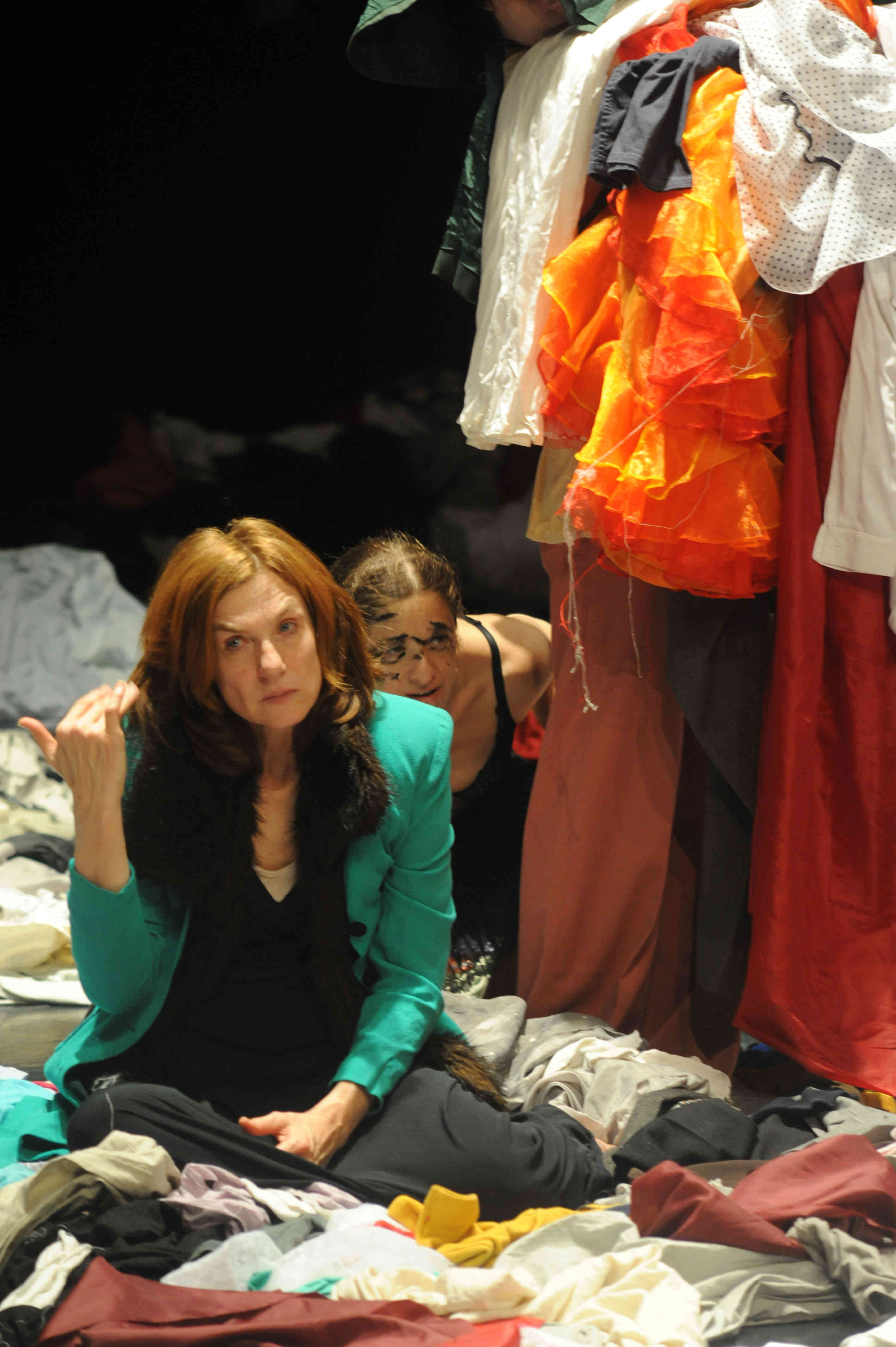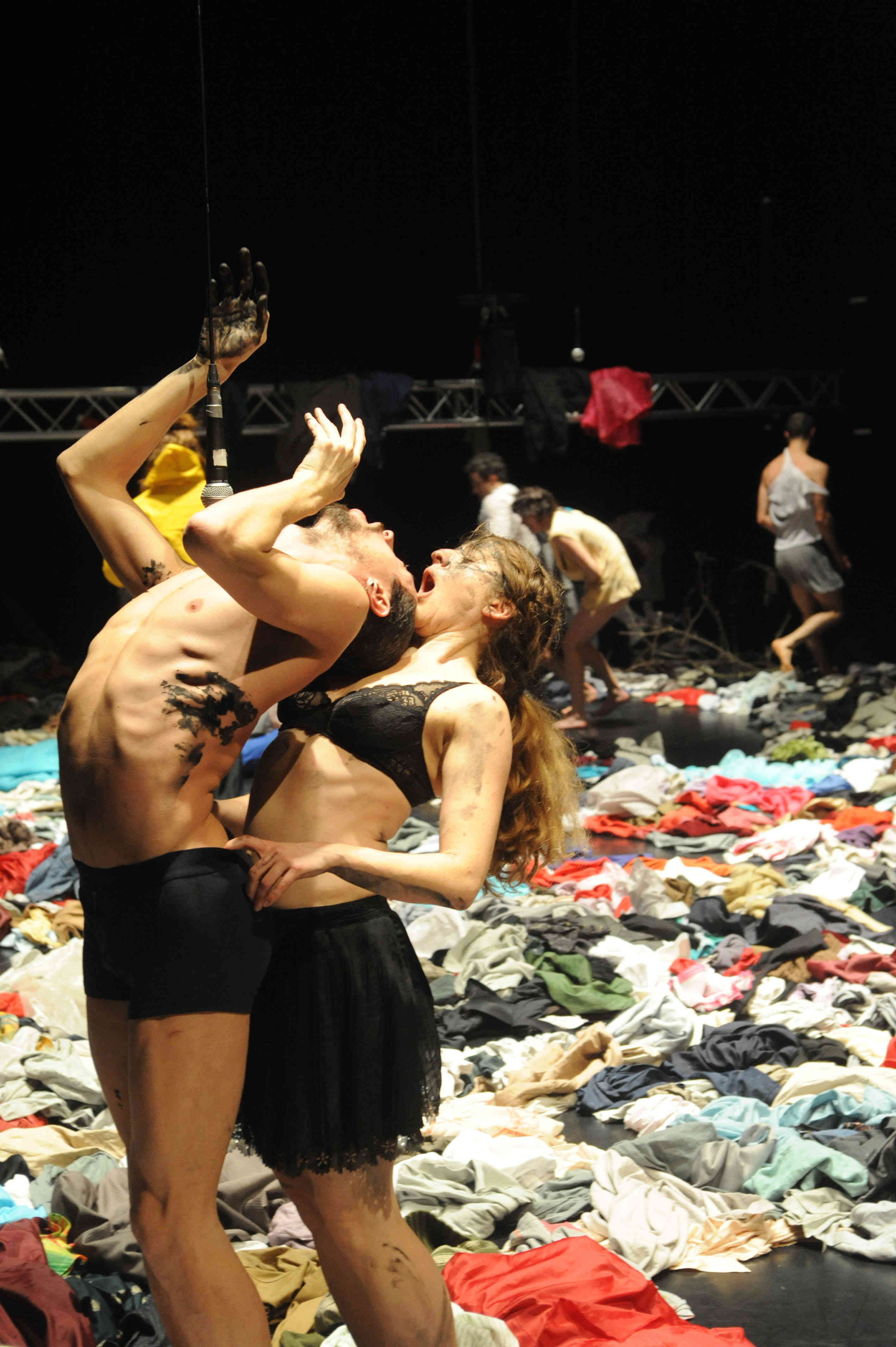Belgian Alain Platel makes the kind of dance theatre (like Pina Bausch, to whom he has an oft-remarked debt) for which both “dance” and “theatre” are very loose and inadequate umbrella terms. “Sets” are often jaw-dropping colonisations of stage space; there are no flats or drops painted to resemble other things, but huge quantities of actual stuff with which the dancers interact. These “dancers” are actors too, but their “dialogue” is not continuous speech but snatches and fragments, absurd and incongruous phrases which sit in the air like the absurd and incongruous objects on the stage. And it is through the intensity of these dance-actors that both Bausch and Platel’s work succeeds: they compel audiences with their total commitment to the world of the piece, seemingly in disregard of their own dignity, comfort, or even safety.
In tauberbach, Platel’s latest work with his own company, les ballets C de la B, the stage is colonised by clothes, heaps and dunes of them, entirely covering the floor. Visually, they stand for the rubbish dump on which the main character, played by Elsie de Brauw and inspired by a real Brazilian woman called Estamira, lives and works. Estamira has mental health problems, and tauberbach, like much of Platel’s oeuvre, explores the world of the differently abled in a way that makes the truth of that description abundantly clear: there is no divisive ‘dis’ standing between an able “us” and a disabled “them”, but instead one clear, continuous humanity.
 Dance is the ideal medium to explore these issues, and not only because dancers themselves are so differently abled (the line between what is considered art and what is considered merely spectacular, or even freakish, is extremely culturally variable, as anyone will recognise who has ever heard an elderly ballerina sniff dubiously about the “acrobatics” of a younger generation). We reason readily with our bodies, and they are our most basic means of communication: when accessories like language and even gesture fail, the simple presence of a body is still powerful – think how tenderly we (at least aspire to) treat bodies which cannot speak for themselves: newborn babies, the gravely ill, the dead.
Dance is the ideal medium to explore these issues, and not only because dancers themselves are so differently abled (the line between what is considered art and what is considered merely spectacular, or even freakish, is extremely culturally variable, as anyone will recognise who has ever heard an elderly ballerina sniff dubiously about the “acrobatics” of a younger generation). We reason readily with our bodies, and they are our most basic means of communication: when accessories like language and even gesture fail, the simple presence of a body is still powerful – think how tenderly we (at least aspire to) treat bodies which cannot speak for themselves: newborn babies, the gravely ill, the dead.
Platel (who once worked as a teacher of children with special needs) understands this language of bodily presence and its role in empathy. De Brauw (pictured above right) moves physically through Estamira’s clothing wasteland and verbally through the confused world of her mind with the same mixture of awkwardness and grace. Sometimes she is jittery or aggressive or sad, riping rags, or raging at the deep, reverberating, often sinister voiceover which may or may not be in her head; at other times she is entirely lucid and suffused with luminous dignity, as when she stands starkly beautiful in a black evening dress, or asserts “I was born perfect” - even as the other characters try to undermine her with mockery and eventually physical assault.
 These others function as echoes of Estamira’s mental state, as well as characters in their own right with their own plethora of experiences. Among them, Ross McCormack stands out for his compelling range of vocal effects, and the near-alien movement quality of tall, lanky, disconcertingly flexible Romeu Runa (pictured left) will be seared into the brain of every audience member. The dance language is Platel's own: more a quality than a nameable style, and rarely even appearing choreographed. The best sequences are those on the floor which subvert the usual grace of dance gesture: much like the soundtrack of Bach sung by deaf children, who give us rhythm but not melody, the dancers move with a synchronicity we instantly recognise as dance, but contort themselves into shapes that are probably as uncomfortable to do as they are ugly to behold.
These others function as echoes of Estamira’s mental state, as well as characters in their own right with their own plethora of experiences. Among them, Ross McCormack stands out for his compelling range of vocal effects, and the near-alien movement quality of tall, lanky, disconcertingly flexible Romeu Runa (pictured left) will be seared into the brain of every audience member. The dance language is Platel's own: more a quality than a nameable style, and rarely even appearing choreographed. The best sequences are those on the floor which subvert the usual grace of dance gesture: much like the soundtrack of Bach sung by deaf children, who give us rhythm but not melody, the dancers move with a synchronicity we instantly recognise as dance, but contort themselves into shapes that are probably as uncomfortable to do as they are ugly to behold.
The transformation of this ugliness is Platel’s achievement: tauberbach is richly able to find and expose the beauty in what is not conventionally considered beautiful, and in so doing it argues forcefully for the importance of what – and who – is not conventionally considered important. But worthiness of object and means is not fully matched by artistic achievement: tauberbach does not bubble with the rich inventiveness, the delightful ever-new strangeness of Pina Bausch’s best work. There are a few “ah!” moments – as when the dancers play make-believe with clothes like gleeful (though morbid) children, holding a blanket as a machine gun or imitating the blood from a cut throat with the watery silken unfurling of a red scarf – but far from enough to fill a 90-minute run time without repetitive longueurs. An hour would have been more than enough.














Add comment